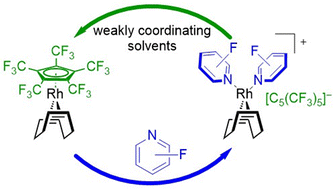Substitution lability of the perfluorinated Cp* ligand in Rh(i) complexes†
Abstract
Several cationic rhodium(I) complexes [Rh(COD)L2][C5(CF3)5] have been synthesized through substitution of the weakly bound [C5(CF3)5]− ligand from [Rh(COD)(C5(CF3)5)], further emphasizing its unique reactivity. Besides acetonitrile, pyridine derivatives with varying degrees of fluorination have been employed as ligands in order to investigate the influence of fluorination upon the binding affinity towards the resulting [Rh(COD)]+ fragment and the limit as to which the [C5(CF3)5]− ligand can be displaced. Furthermore, the newly synthesized compounds represent rare examples of rhodium complexes containing fluorinated pyridines as ligands.

- This article is part of the themed collection: Spotlight Collection: Fluorinated ligands


 Please wait while we load your content...
Please wait while we load your content...